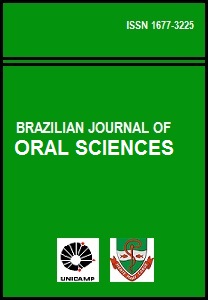Abstract
The purpose of this study was to evaluate, through computerized electrosonography, the effectiveness of interocclusal appliance therapy, used by patients with temporomandibular disorders. Twenty two patients, male and female, ages between 18 and 53 years old, with temporomandibular disorders, were examinated and treated. The electrosonographic evaluations were carried out before the beginning of the treatment and 90, 120, 150 days after using the interocclusal appliance. It is important to emphasize that these appliances received canine guidance and group function modification at the 90th and 120th day, respectively. The collected informations were submitted to statistical analysis of polinomial regression, and revealed had a significant increase in joint sounds frequency in the right TMJ.References
Garcia AR, Madeira MC Ruídos articulares e o tratamento das desordens temporomandibulares. Rev Assoc Paul Cir Dent 1999; 53: 109-15.
Moffett B The morphogenesis of the temporomandibular joint. Am J Orthod Dentofacial Orthop 1966; 52: 401-15.
Vincent SD, Lilly GE Incidence and characterization of temporomandibular joint sounds in adults. J Am Dent Assoc 1988; 116: 203-6.
Farrar WB, McCarty WL. Inferior joint space arthography and characteristics of condylar paths in internal derangements of the TMJ. J Prosthet Dent 1979; 41: 548-55.
Tallents RH, Hatala M, Katzberg RW, Westesson PL Temporomandibular joint sounds in asymptomatic volunteers. J Prosthet Dent 1993; 69: 298-304.
Dylina TJ. A common-sense approach to splint therapy. J Prosthet Dent 2001; 86: 539-45.
Landulpho AB, Silva WAB, Silva FA, Vitti M. The effect of the occlusal splints on the treatment of temporomandibular disorders: a computerized electromyographic study of masseter and anterior temporalis muscles. Electromyogr clin Neurophysiol 2002; 42: 187-91.
Bracco P, Deregibus A, Piscetta R, Giaretta GA. TMJ clicking: a comparison of clinical examination, sonography, and axiography. J Craniomandib Pract 1997; 15: 121-6.
Hutta JL, Morris TW, Katzberg RW, Tallents RH, Espeland MA. Separation of int ernal derangements of the temporomandibular joint using sound analysis. Oral Surg Oral Med Oral Pathol 1987; 63: 151-7.
Mohl ND. Reliability and validity of diagnostic modalities for temporomandibular disorders. Adv Dent Res 1993; 7:113-9.
Sutton DI, Sadwsky L, Bernreuter WK, McCutcheon MJ, Lakshminarayanan AV. Temporomandibular joint sounds and condyle/disk relations on magnetic ressonance images. Am J Orthod Dentofacial Orthop 1992; 101: 70-8.
Dimitroulis G, Gremillion HA, Dolwick MF, Walter JH. Temporomandibular disorders. 2. Non-surgical treatment. Aust Dent J 1995; 40: 372-6.
Wright EF, Schiffman EL. Treatment alternatives for patients with masticatory myofascial pain. J Am Dent Assoc 1995; 126: 1030-9.
Carraro JJ, Caffesse RG. Effects of occlusal splints on TMJ symptomatology. J Prosthet Dent 1978; 40: 563-6.
Goharian RK, Neff P. Effects of occlusal retainers om temporomandibular joint and facial pain. J Prosthet Dent 1980; 44: 206-8.
Greene CS, Laskin DM. Splint therapy for the myofascial pain-dysfunction (MPD) syndrome: a comparative study. J Am Dent Assoc 1972; 84: 624-8.
Magnusson T, Carlsson GE. Treatment of patients with functional disturbances in the masticatory system. A survey of 80 consecutive patients. Swed Dent J 1980; 4: 145-53.
Sheikholeslam A, Holmgren K, Riise C. Therapeutic effects of the plane occlusal splint on signs and symptoms of craniomandibular disorders in patients with nocturnal bruxism. J Oral Rehabil 1993; 20: 473-82.
Christensen LV, Orloff J. Reproducibility of temporomandibular joint vibrations (electrovibratography). J Oral Rehabil 1992; 19: 253-63.
Olivieri KAN, Garcia AR, Paiva G, Stevens C. Joint vibrations analysis in asymptomatic volunteers and symptomatic patients. J Craniomandib Pract 1999; 17: 176-83.
Garcia AR, Madeira MC, Paiva G, Olivieri KAN. Joint vibration analysis in patients with articular inflammation. J Craniomandib Pract 2000; 18: 272-9.
Gallo LM, Airoldi R, Ernst B, Palla S Power spectral analysis of temporomandibular joint sounds in asymptomatic subjects. J Dent Res 1993; 72: 871-5.
Owen AH Rationale and utilization of temporomandibular joint vibration analysis in na orthopedic practice. J Craniomandib Pract 1996; 14: 2: 139-53.
McCarroll RS, Naeije M, Kim YK, Hansson TL Short-term effect of a stabilization splint on the asymmetry of submaximal masticatory muscle activity. J Oral Rehabil 1989;16: 171-6.
The Brazilian Journal of Oral Sciences uses the Creative Commons license (CC), thus preserving the integrity of the articles in an open access environment.

